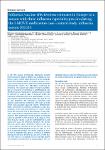Influenza vaccine effectiveness estimates in Europe in a season with three influenza type/subtypes circulating: the I-MOVE multicentre case–control study, influenza season 2012/13
Kissling, E.
Valenciano, M.
Buchholz, Udo
Larrauri, A.
Cohen, J. M.
Nunes, B.
Rogalska, J.
Pitigoi, D.
Paradowska-Stankiewicz, I.
Reuss, Annicka
Jiménez-Jorge, S.
Daviaud, I.
Guiomar, R.
O’Donnell, J.
Necula, Gheorghe
Głuchowska, M.
Moren, A.
In the fifth season of Influenza Monitoring Vaccine Effectiveness in Europe (I-MOVE), we undertook a multicentre case–control study (MCCS) in seven European Union (EU) Member States to measure 2012/13 influenza vaccine effectiveness against medically attended influenza-like illness (ILI) laboratory confirmed as influenza. The season was characterised by substantial co-circulation of influenza B, A(H1N1)pdm09 and A(H3N2) viruses. Practitioners systematically selected ILI patients to swab ≤7 days of symptom onset. We compared influenza-positive by type/subtype to influenza-negative patients among those who met the EU ILI case definition. We conducted a complete case analysis using logistic regression with study as fixed effect and calculated adjusted vaccine effectiveness (AVE), controlling for potential confounders (age, sex, symptom onset week and presence of chronic conditions). We calculated AVE by type/subtype. Study sites sent 7,954 ILI/acute respiratory infection records for analysis. After applying exclusion criteria, we included 4,627 ILI patients in the analysis of VE against influenza B (1,937 cases), 3,516 for A(H1N1)pdm09 (1,068 cases) and 3,340 for influenza A(H3N2) (730 cases). AVE was 49.3% (95% confidence interval (CI): 32.4 to 62.0) against influenza B, 50.4% (95% CI: 28.4 to 65.6) against A(H1N1)pdm09 and 42.2% (95% CI: 14.9 to 60.7) against A(H3N2). Our results suggest an overall low to moderate AVE against influenza B, A(H1N1)pdm09 and A(H3N2), between 42 and 50%. In this season with many co-circulating viruses, the high sample size enabled stratified AVE by type/subtype. The low estimates indicate seasonal influenza vaccines should be improved to achieve acceptable protection levels.
No license information
Related Items
Show related Items with similar Title, Author, Creator or Subject.
-
2016-10-13ZeitschriftenartikelImproving influenza virological surveillance in Europe: strain-based reporting of antigenic and genetic characterisation data, 11 European countries, influenza season 2013/14 Broberg, E.; Hungnes, Olav; Schweiger, Brunhilde; Prosenc, Katarina; Daniels, R.; Guiomar, R.; Ikonen, N.; Kossyvakis, A.; Pozo, Francisco; Puzelli, S.; Thomas, I.; Waters, A.; Wiman, Å.; Meijer, AdamInfluenza antigenic and genetic characterisation data are crucial for influenza vaccine composition decision making. Previously, aggregate data were reported to the European Centre for Disease Prevention and Control by ...
-
2016-02-18ZeitschriftenartikelVaccine effectiveness in preventing laboratory-confirmed influenza in primary care patients in a season of co-circulation of influenza A(H1N1)pdm09, B and drifted A(H3N2), I-MOVE Multicentre Case–Control Study, Europe 2014/15 Valenciano, Marta; Kissling, Esther; Reuss, Annicka; Rizzo, C.; Gherasim, A.; Horváth, Judit K.; Domegan, L.; Pitigoi, Daniela; Machado, Ausenda; Bella, A.; Paradowska-Stankiewicz, I.; Larrauri, A.; Ferenczi, A.; O´Donell, Joan; Lazar, M.; Pechirra, P.; Korczyńska, M. R.; Pozo, Francisco; Moren, A.Influenza A(H3N2), A(H1N1)pdm09 and B viruses co-circulated in Europe in 2014/15. We undertook a multicentre case–control study in eight European countries to measure 2014/15 influenza vaccine effectiveness (VE) against ...
-
2013-02-14ZeitschriftenartikelEarly estimates of seasonal influenza vaccine effectiveness in Europe: results from the i-move multicentre case–control study, 2012/13 Valenciano, M.; Kissling, E.We conducted a test-negative case–control study based in five European sentinel surveillance networks. The early 2012/13 adjusted influenza vaccine effectiveness was 78.2% (95% CI: 18.0 to 94.2) against influenza B, 62.1% ...

